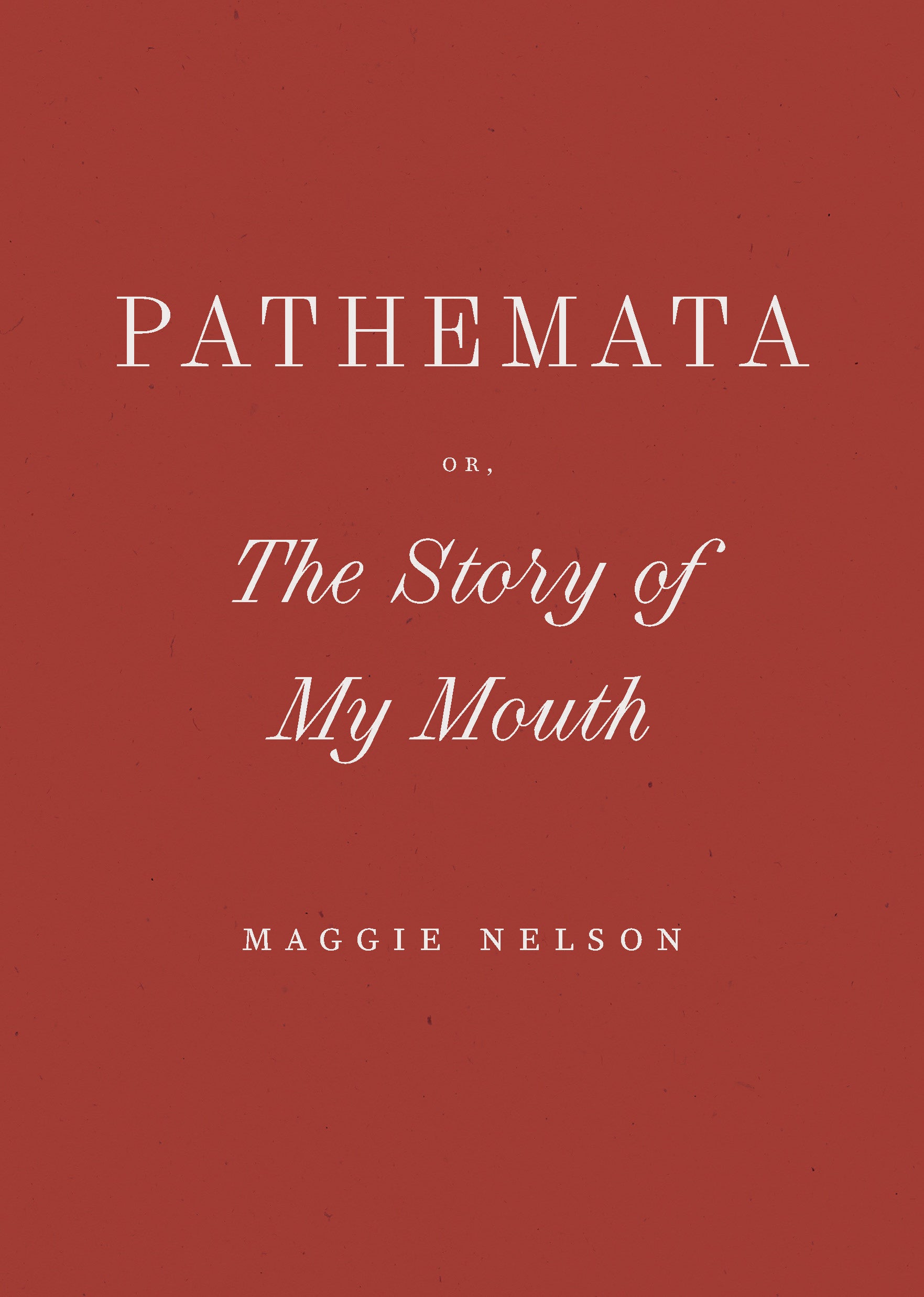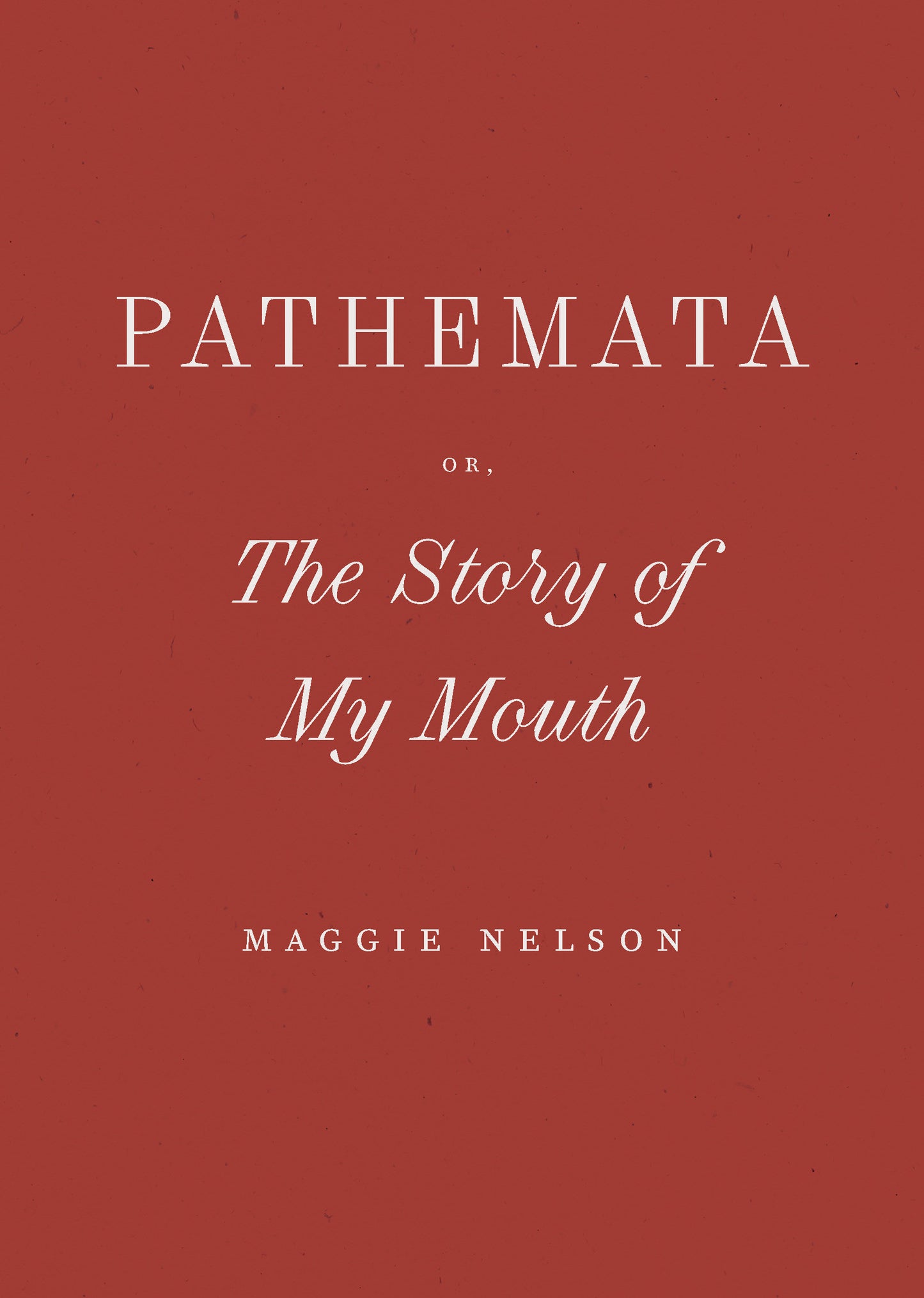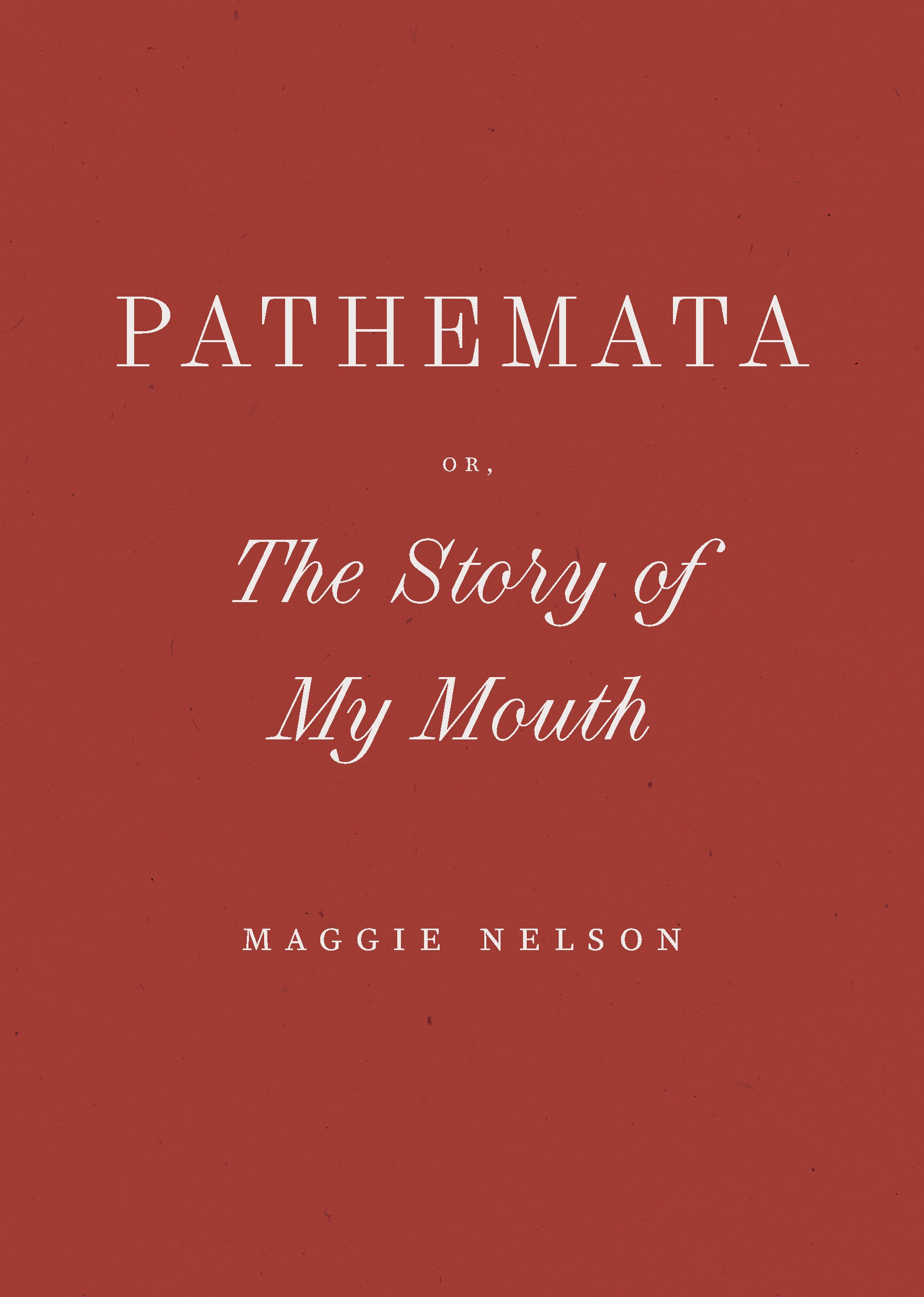
Pathemata, Or, The Story of My Mouth
Pathemata, Or, The Story of My Mouth
-
Pathemata, Or, The Story of My Mouth, is an experiment in interiority written in the pandemic studio. Something of a companion piece to 2009’s Bluets, Pathemata merges a pain diary chronicling a decade of jaw pain with dreams and dailies, eventually blurring the lines between embodied, unconscious, and everyday life. In scrupulously distilled prose, Pathemata offers a tragicomic portrait of a particularly unnerving and isolating moment in recent history, as well as an abiding account of how it feels to inhabit a mortal body in struggle to connect with others. Formally inspired by Hervé Guibert’s The Mausoleum of Lovers, and conceptually guided by Gilles Deleuze’s notion of artist as symptomologist, Pathemata is yet another urgent innovation from Maggie Nelson in the art of life-writing.
-
Praise for Pathemata, Or, The Story of My Mouth:
This unique work embodies its own definitions of hybridity responding to the conditions of its making—a pandemic, a history of mouth issues, a series of dentists, parenthood—as well as to Hervé Guibert’s The Mausoleum of Lovers. This is “an experiment in interiority written in the pandemic studio” book. This is a Wave book. Fans of Nelson will want Pathemata on their shelves.
RMF, Lit Hub
Previous Praise for companion book, BluetsBalancing pathos with philosophy, she created a new kind of classicism, queer in content but elegant, almost cool in shape.
Hilton Als, The New Yorker
This set of meditations on the colour blue is full of wisdom and beauty.
The Guardian
Nelson's expressive style springs from her subject as much as the content, in turn, inflects her vocabulary, tone and structure. Seeking such reciprocity—no less an ideal than, say, “the spontaneous overflow of powerful feelings”—may radically redefine poetry, as it increasingly becomes the genre that is not one.
Albert Mobilio, Bookforum
Building the book as a collection of facts and quotations, Nelson interweaves her own insights, textual interpretations, and anecdotes ranging from the tragic to the outrageous. Nelson may, admittedly, have fallen short of the “compendium of blue observations, thoughts, and facts” she says she at first envisioned, but this slim volume is nonetheless an elegant, indispensable addition to the genre of the lyric essay.
Kathleen Rooney, Boston Review
From blue factoids like Benedict de Saussure’s 1789 invention of “cyanometer, with which he hoped to measure the blue of the sky,” to her own struggles with depression, Nelson gifts us with what seems like a lifetime study of blue while somehow slyly avoiding any of the obvious “blue” clichés. Maggie Nelson continues to raise the bar higher in what a reader can expect from a book. Bluets is smart yet intimate, quiet yet provocative, and a welcome addition to the poetic non-fiction discourse.
Susie DeFord, BOMB
In the end Nelson breaks free of romance’s tyranny. She dreams someone sends her cornflowers, the American name for bluets. Shaggy, wild, and strong—they’re a revealing metaphor for the author.
Jeffrey Cyphers Wright, The Brooklyn Rail
In 240 entries, Nelson relates a history of blue from philosophical, zoological and literary perspectives, all the while weaving in bits of memoir and emotional rumination. Through this collage, she broadens the definition of blue from a merely visual phenomenon to a vehicle for the divine.
Catherine Lacey, Time Out New York
It’s an impossible book to describe without simply handing it to you; it is, hackneyed as it is to say, a book to be experienced. I can only report that I am reading it again and again, that the resonances between the (seemingly) disparate propositions are startling and emotional, that I suspect your reaction will be different and also quite wonderful.
Peter Rock, The Rumpus
Brash, feverish, intractable, exploratory, and terribly “touchant” Nelson’s Bluets is, I am remind’d for some reason (it’s in Marías) of Rimbaud’s line: “Par délicatesse / J’ai perdu ma vie.”
John Latta, Isola di Rifuti
In the 240 prose entries the book consists of, Nelson deals with the personal loss of a relationship and witnesses the physical suffering of a friend who became a quadriplegic following an accident (something Nelson also wrote about in her 2007 poetry collection, Something Bright, Then Holes), all while returning again and again to the color blue.
Gina Myers, Bookslut
Nelson doesn’t want to leave anything out, as suits a collector’s project. Thus, in the same way that she wanders among blue objects (shards of glass, bottles of ink, stones and tattoos and the nests of bowerbirds) and accidental theorists of color (Goethe and Newton and Duras and Novalis) and the color’s utility in human imagination (blue moods, blues music, the blue divine), she likewise wanders among the positions the orchestrator of these lists must adopt. This results in an admixture of candor, passion and detachment that makes for irresistible intimacy.
Ray McDaniel, The Constant Critic
It must be said upfront that Maggie Nelson could have worked this out as a book of poetry if that’s what she had wanted to do early on. Which is to say, for a book that might actually be an essay, which might be a lyrical essay, for a long work that “blurs genre,” she fills the requirement of what good poetry must do, which is deliver new ways of talking and looking and thinking, and helping us to look and think.
Ben Fama, Fanzine
The book is a philosophical and personal exploration of what the color blue has done to Nelson. Despite the exhaustion, Bluets wears its hybrid/fragmented dress well, showing its seams and much enthralled by its wanderlust, an aesthetic runway that constantly leads Nelson to find new ideas, images, and expressions.
Thomas Larson, TriQuarterly
Bluets reaches far beyond the constraints of its subject, resulting in a series of delicately associative numbered paragraphs investigating a broken romantic relationship, a friend’s chronic nerve pain, the writing process itself, and the deceptive elements of perception and color. The result not only defies easy categorization, but also leans toward Walter Benjamin’s famous declaration that all great works of literature either dissolve a genre or invent one.
Rob Schlegel, Jacket
Incandescent prose with a structural flow unlike anything I’ve ever read. A book beyond genre that deals with deep topics playfully, offering revelatory insights on every page. I read this book on an airplane and I will never be the same.
Chad Murphy, Document -
- Maggie Nelson is the author of twelve books of poetry and prose, many of which have become cult classics defying categorization. She first published Bluets with Wave Books in 2009 - in 2015, the book was named by Bookforum one of the top 10 best books of the past 20 years; in 2024, it was adapted into an acclaimed play staged at the Royal Court Theater of London. Her other nonfiction titles include Like Love: Essays and Conversations (2024), On Freedom: Four Songs of Care and Constraint (2021; named a New York Times Notable Book of the Year), the National Book Critics Circle Award winner The Argonauts (2015; named by the New York Times one of the top 100 books of the 21st Century), The Art of Cruelty: A Reckoning (2011; named a New York Times Notable Book of the Year), The Red Parts: Autobiography of a Trial (2007), and Women, the New York School, and Other True Abstractions (2007). Her poetry titles include Something Bright, Then Holes (2007), and Jane: A Murder (2005). A 2016 MacArthur “genius” fellow, she currently teaches at the University of Southern California and lives in Los Angeles.
Publication Month: April 2025
Trade hardcover
ISBN# 9798891060111 (5.75x8 80pp, hardcover)
Couldn't load pickup availability


